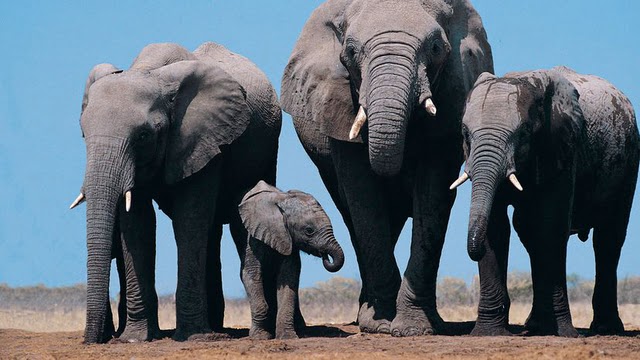Quck answer
Elephants have cracked skin due to their thick epidermis, lack of sweat glands, and frequent exposure to the sun and dry environments. However, they have evolved special adaptations to protect their skin, such as thicker skin on their ears and softer skin in their trunk. They also roll in mud to protect against sunburn and parasites and may use their trunks to spray themselves with water. Scientists have discovered that elephants have unique genes that control the development of their skin and may use these genes to develop new treatments for human skin disorders.
Wild Animals

Elephants have scaly, cracked skin from birth due to an evolutionary adaptation that protects them from the sun’s intense rays. Unlike other species, the crackled appearance of elephant skin is not a sign of aging or skin shrinkage. The cracks allow the skin to retain moisture and dirt, which reduces the harmful effects of the sun and prevents wild swings in body temperature. Elephant skin is resistant to shedding and has a lot more keratin than human skin, making it more durable. The wrinkles in their skin serve as a complex system of channels that capture and hold moisture and dirt. Elephants also use water and mud to settle into the tiny cracks in their skin, which keeps them cooler. The skin cracks in geometric shapes that approximate other common sights in our world, resulting in a durable cooling system that keeps the gigantic mammals from cooking in their own thick skin on hot days.
Michel Milinkovitch, a professor at the Department of Genetics and Evolution in the University of Geneva Faculty of Science, led a team of researchers who studied the pachyderm epidermis using light and electron microscopes, along with intricate computing modeling. Their research was published in the journal Nature Communications on Oct. 2. 2018. Elephants are pachyderms, which means they have thick skin. These enormous warm-blooded animals can weigh around 11 tons and measure up to 13 feet tall at the shoulder. Elephants cannot sweat, and their skin is subject to everyday movement, like bending and twisting, which quickly wrinkles it. The wrinkles serve as a channel for moisture and dirt, which helps elephants retain hydration and prevent overheating.
Elephants Have a Natural Defense Against Cancer
Despite their large size and frequent exposure to the sun, elephants have a low incidence of skin cancer. This is due, in part, to a gene known as P53. The elephants’ body chemistry recognizes DNA abnormalities and eliminates cells that could potentially develop into tumors. Researchers are currently studying these “zombie genes” to determine their potential impact on human biology.
FAQ
1. What causes elephants’ skin to be so cracked?
Elephants’ skin is cracked because they don’t have sweat glands to moisturize their skin. Instead, they use dust baths and mud to protect their skin from the sun and to keep it moist.
2. Is cracked skin harmful to elephants?
Cracked skin is not harmful to elephants as long as it doesn’t get infected. Elephants have thick skin that protects them from external injuries, but they can still suffer from internal diseases.
3. Can elephants get skin cancer from being exposed to the sun?
Elephants can get skin cancer, but it’s relatively rare. Their thick skin and the fact that they use dust baths and mud to protect themselves from the sun reduce the risk of skin cancer.
4. What is the role of elephant skin in regulating body temperature?
Elephant skin helps regulate body temperature by dissipating heat through the cracks in their skin. The cracks create a larger surface area for heat to escape, which keeps elephants cool in hot environments.
5. How do elephants keep their skin clean?
Elephants keep their skin clean by using their trunks to spray themselves with water, and by rubbing against trees and rocks to remove dirt and dead skin. They also use dust baths and mud to keep their skin healthy.
6. Do different elephant species have different skin characteristics?
There are three species of elephants: African forest elephants, African savanna elephants, and Asian elephants. While each species has unique physical characteristics, their skin is relatively similar in terms of thickness and texture.
7. Can elephants feel pain from their cracked skin?
Elephants have nerve cells in their skin, so they can feel pain from external injuries. However, cracked skin is not necessarily painful for elephants, as their skin is thicker and less sensitive than human skin.
8. What are some other unique characteristics of elephant skin?
Elephant skin is incredibly thick, with some areas of the skin measuring up to three centimeters in thickness. Additionally, elephant skin has a unique texture that allows it to grip objects, which helps elephants pick up food and use tools.
9. How does elephant skin compare to human skin?
Elephant skin is much thicker and coarser than human skin. Additionally, elephant skin lacks hair follicles and sweat glands, which are present in human skin.
10. Is there anything humans can learn from the way elephants care for their skin?
Humans can learn a lot from the way elephants care for their skin. For example, using natural materials like mud and dust to protect and moisturize the skin can be an effective alternative to using chemical-based products. Additionally, taking regular baths and using water to clean the skin can help maintain a healthy and moisturized complexion.





Leave a Reply